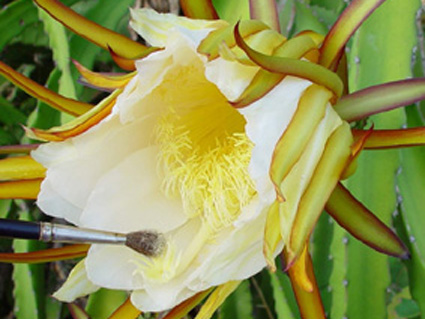photo 3 / 28
As I haven’t any photograph of the pollination of Epiphyllum oxypetalum, to write this page I used a photograph of the manual pollination of a bloom of Hylocereus purpusii (a plant which gives the well-known Dragon Fruit with red pulp). The technique of pollination is the same for both flowers.
This manual pollination requires the simultaneous blooming of two different clones of the same plant. If the two clones are not simultaneously in bloom, the pollen of the first clone in bloom must be collected and kept cold until the blossoming of the second clone.
Each bloom is at the same time male by its stamens whose anthers (tips) carry pollen, and female by the pistil which has two ends : the stigma, which receives pollen (visible on the photograph); the other end of the pistil includes the ovary and the ovule in which the seeds are forming.
The pollen of one of the two clones must be taken on the stamens
of this clone with the use of a brush, then be transported and deposited,
still with the brush, on the stigma of the pistil of the other
clone bloom. (this is the stage shown on the above photograph).
_________________________________________________________________________
____________________________________________________________________________________
